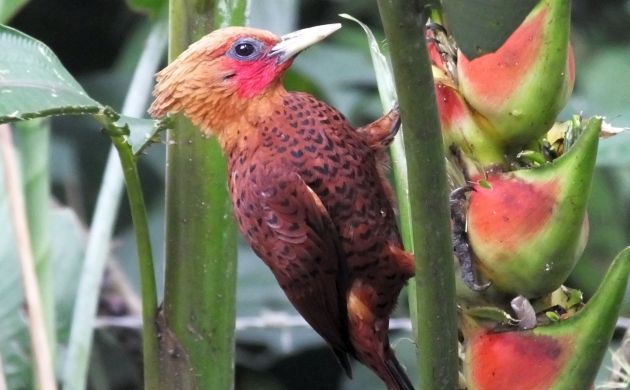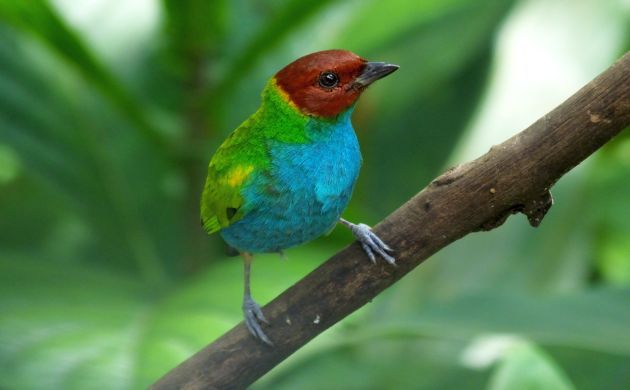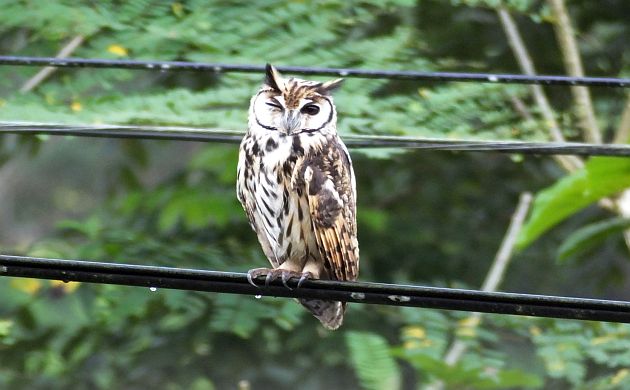
The tenth month of the year isn’t one that is commonly associated with birding in Costa Rica but no matter, it should be. Those with binoculars who visit now will still lays eyes on lots of birds. There’s always the chance that your trip might coincide with a tropical storm but that doesn’t happen every year and when it does, it’s only for a few days or maybe a week (and also gives you the chance to put your waterproof optics to the test). Even if that storm does hit, after the rain, the birds tend to come out in droves and at the end of the day, it’s as birdy during the latter half of autumn as it is during the birding popular month of March. That said, if you happen to be in country at this time (or wish that you were), you may find the following information of use:
Bring an umbrella: In Costa Rica, that goes for any time of the year but may come more in handy now. And it is worth it to bring one because if the rain is light or intermittent, you will see a lot more birds during such a forecast than a bright, sunny tropical UV slamming day. The umbrella is also handy because ponchos are unwieldy (they kind of suck), and in tropical climates, rain jackets tend to convert themselves into portable saunas.
Focus on the bird action in the morning: To keep the birding real, make sure to get out there at dawn and bird all morning. Yes, most of us follow that rubric anyways but in October, it’s especially important to stick to the birding plan just in case the sky faucets get turned on after lunch. The birds are super active in the morning because they don’t take any chances with rain and neither should you.
Watch for fruiting trees: Thanks to lots of heavy rain this year, there is a bonanza of fruit and the birds are going crazy. At least that’s what it seemed like this morning and that was just a cursory hour of birding in shade coffee near my home. As I searched for hidden cuckoos and other migrants, the foliage was shaking with the busy behavior of thrushes, tityras, and other birds feasting on figs and small fruits. The action was impressive and if it was any indication of similar situations in other parts of the country, the tanager action on the Caribbean slope could be fierce. Check out my eBird list.

Beautiful Bay-headed Tanagers like fruiting trees.
Some roads might be closed: Given the massive wet punch that Tropical Storm Nate gave us last week, it’s no surprise that several roads remain closed. Several others have been fixed but a choice few have serious issues (as might be expected when exposed to a month’s worth of erosion in 24 hours) including the main road over Cerro de la Muerte. There has been a lot of help for people who have lost their homes to the storm and we are slowly but surely fixing stuff but some sites might be closed for a few weeks and minor roads that have been washed out might not get fixed for a while. That doesn’t mean that the entire country is inaccessible, in fact, you can still drive to most places. It’s just a good idea to check the status of routes you hope to take before venturing in that direction. Using the Waze app is probably the easiest way to check road status but you can also look at this official site.
Consider the Caribbean: Since most of the damage from Nate has happened on the Pacific slope, you couldn’t do wrong by sticking to the Caribbean. There are, after all, a heck of a lot of birds over there including juicy targets like Bare-necked Umbrellabird, Snowy Cotinga, Semiplumbeous Hawk, and a few hundred other species. As often happens at this time of the year, the Caribbean sees less rain than the Pacific and with thousands of migrants passing through the northern part of the country, it’s also pretty darn exciting. When you get tired of scanning for cotingas, feast your eyes on a river of thousands of migrating raptors (seriously), scout rainforest trails for Olive-backed Quail-Dove and antbirds, or look for several species of beautiful woodpeckers.

Such as the eye-pleasing Chestnut-colored Woodpecker.
eBird your sightings: Always a worthwhile endeavor but especially for folks like me who want to identify more than 700 species during 2017. Like, if you see something that seems mundane like a Palm Warbler or Least Flycatcher, oh yes, please report them because they and several other species are choice rare birds in Costa Rica. And, I still need them for my year list.
The first Costa Rica bird race is happening now: Yes, it is happening right now and since our very own Dragan is participating, we may be hearing about it! If you are wondering why you hadn’t heard about it before or why you couldn’t bring a team to participate, it’s because the event is a fun, easy going race/challenge meant to promote lodges associated with the Costa Rica Birding Hotspots route as well as birding in Costa Rica in general. It will be interesting to see how many species they find during eight days of intense birding at various sites in the country.

Will they see a Striped Owl? Recently, this one was right in front of Carara National Park.
Check out the “Festival Bienvenidos Aves Migratorias” at the end of the month in Santa Elena del General: Organized by birder and guide Susana Garcia Blanco, this fun event includes everything from bird tours (like for seeing Turquoise Cotinga), to games for kids, bingo, and even karaoke and a dance! It will be an excellent way to meet local people and promote birds by celebrating them, especially species like the Golden-winged Warbler and other migrants that use the important tropical forests of the General Valley.
There are no doubt other things of avian importance happening in Costa Rica right now but the most important is just getting into quality habitat and seeing what you can find. I hope to see you at an antswarm, during mixed flock madness, or some other birdy situation in Costa Rica.











One thing I was trying to discover before the trip: what kind of weather to expect. And I didn’t, not really. Once I found myself in Costa Rica in October, I realised that it is way too humid for any sort of a rain gear.
Even more odd, there was hardly any rain. In the dry season Caribbean side there was some mild and short-lasting rain daily. At the rainy season Pacific side, the things were quite different. Near Carara, there was a short downpour or two, but further north, in the Nicoya Gulf, the weather was bright and sunny, no trace of rain.
Later, in San Hose, the morning was perfect (or perfecto), sunny, moderate wind, no humidity… And that was when I had to head to the airport.